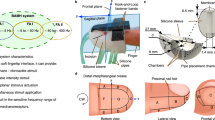Abstract
The phenomenon of illusory pulling force, induced by asymmetric vibrations, represents a distinct perceptual experience. This pseudo-force sensation has been explored through various techniques involving the deployment of multiple vibrotactile actuators. Although these actuators can elicit multi-dimensional pseudo-forces, the impact of distance between actuators on the rotational pseudo-force (or torque sensation) remains unexplored. This study examines the influence of vibrotactile actuator distance on the pseudo-torque sensation elicited by asymmetric vibrations. We hypothesized that the distance between actuators impacts the perceived pseudo-torque in line with the principle of leverage. Our findings indicate an increase in perceived pseudo-torque up to a 50 mm separation between actuators, with an optimal distance correlating to 0.43 times the hand size for effective pseudo-torque generation. These insights are crucial for designing haptic devices capable of imparting pseudo-torque sensations.
Supported by Toyota Central R&D Labs., Inc.
Access this chapter
Tax calculation will be finalised at checkout
Purchases are for personal use only
Similar content being viewed by others
References
Amemiya, T., Ando, H., Maeda, T.: Lead-me interface for a pulling sensation from hand-held devices. ACM Trans. Appl. Percept. 5(3), 1 (2008). https://doi.org/10.1145/1402236.1402239
Amemiya, T., Gomi, H.: Buru-navi3: Behavioral navigations using illusory pulled sensation created by thumb-sized vibrator. In: ACM SIGGRAPH 2014 Emerging Technologies. SIGGRAPH ’14, Association for Computing Machinery, New York, NY, USA (2014). https://doi.org/10.1145/2614066.2614087
Amemiya, T., Gomi, H.: Distinct pseudo-attraction force sensation by a thumb-sized vibrator that oscillates asymmetrically. In: Auvray, M., Duriez, C. (eds.) Haptics: Neuroscience, Devices, Modeling, and Applications, pp. 88–95. Springer Berlin Heidelberg, Berlin, Heidelberg (2014). https://doi.org/10.1007/978-3-662-44196-1_12
Choi, I., Culbertson, H., Miller, M.R., Olwal, A., Follmer, S.: Grabity: A wearable haptic interface for simulating weight and grasping in virtual reality. In: Proceedings of the 30th Annual ACM Symposium on User Interface Software and Technology, pp. 119–130. UIST ’17, Association for Computing Machinery, New York, NY, USA (2017). https://doi.org/10.1145/3126594.3126599
Culbertson, H., Walker, J.M., Okamura, A.M.: Modeling and design of asymmetric vibrations to induce ungrounded pulling sensation through asymmetric skin displacement. In: 2016 IEEE Haptics Symposium (HAPTICS), pp. 27–33 (2016). https://doi.org/10.1109/HAPTICS.2016.7463151
Culbertson, H., Walker, J.M., Raitor, M., Okamura, A.M.: Waves: A wearable asymmetric vibration excitation system for presenting three-dimensional translation and rotation cues. In: Proceedings of the 2017 CHI Conference on Human Factors in Computing Systems, pp. 4972–4982. CHI ’17, Association for Computing Machinery, New York, NY, USA (2017). https://doi.org/10.1145/3025453.3025741
Imaizumi, A., Okamoto, S., Yamada, Y.: Friction sensation produced by laterally asymmetric vibrotactile stimulus. In: Auvray, M., Duriez, C. (eds.) Haptics: Neuroscience, Devices, Modeling, and Applications, pp. 11–18. Springer, Berlin Heidelberg, Berlin, Heidelberg (2014). https://doi.org/10.1007/978-3-662-44196-1_2
Maeda, T., Yamamoto, J., Yoshimura, T., Sakai, H., Minamizawa, K.: Waylet: Self-contained haptic device for park-scale interactions. In: SIGGRAPH Asia 2023 Emerging Technologies. SA ’23, Association for Computing Machinery, New York, NY, USA (2023). https://doi.org/10.1145/3610541.3614567
Rekimoto, J.: Traxion: A tactile interaction device with virtual force sensation. In: Proceedings of the 26th Annual ACM Symposium on User Interface Software and Technology, pp. 427–432. UIST ’13, Association for Computing Machinery, New York, NY, USA (2013). https://doi.org/10.1145/2501988.2502044
Tanabe, T., Fujimoto, Y., Nunokawa, K., Doi, K., Ino, S.: White cane-type holdable device using illusory pulling cues for orientation & mobility training. IEEE Access 11, 28706–28714 (2023). https://doi.org/10.1109/ACCESS.2023.3259965
Tanabe, T., Yano, H., Endo, H., Ino, S., Iwata, H.: Motion guidance using translational force and torque feedback by induced pulling illusion. In: Nisky, I., Hartcher-O’Brien, J., Wiertlewski, M., Smeets, J. (eds.) Haptics: Science, Technology, Applications, pp. 471–479. Springer International Publishing, Cham (2020). https://doi.org/10.1007/978-3-030-58147-3_52
Tanabe, T., Yano, H., Iwata, H.: Evaluation of the perceptual characteristics of a force induced by asymmetric vibrations. IEEE Trans. Haptics 11(2), 220–231 (2018). https://doi.org/10.1109/TOH.2017.2743717
Teshima, T., Takamuku, S., Amemiya, T., Gomi, H.: Light touch on pillar array surface greatly improves direction perception induced by asymmetric vibration. In: SIGGRAPH Asia 2015 Haptic Media And Contents Design. SA ’15, Association for Computing Machinery, New York, NY, USA (2015). https://doi.org/10.1145/2818384.2818404
Ura, S.: An analysis of experiments of paired comparisons. Quality Control 16, 78–80 (1959)
Author information
Authors and Affiliations
Corresponding author
Editor information
Editors and Affiliations
Rights and permissions
Copyright information
© 2025 The Author(s), under exclusive license to Springer Nature Switzerland AG
About this paper
Cite this paper
Maeda, T., Yoshimura, T., Sakai, H., Minamizawa, K. (2025). Enhancing the Perceived Pseudo-Torque Sensation based on the Distance between Actuators Elicited by Asymmetric Vibrations. In: Kajimoto, H., et al. Haptics: Understanding Touch; Technology and Systems; Applications and Interaction. EuroHaptics 2024. Lecture Notes in Computer Science, vol 14768. Springer, Cham. https://doi.org/10.1007/978-3-031-70058-3_25
Download citation
DOI: https://doi.org/10.1007/978-3-031-70058-3_25
Published:
Publisher Name: Springer, Cham
Print ISBN: 978-3-031-70057-6
Online ISBN: 978-3-031-70058-3
eBook Packages: Computer ScienceComputer Science (R0)




